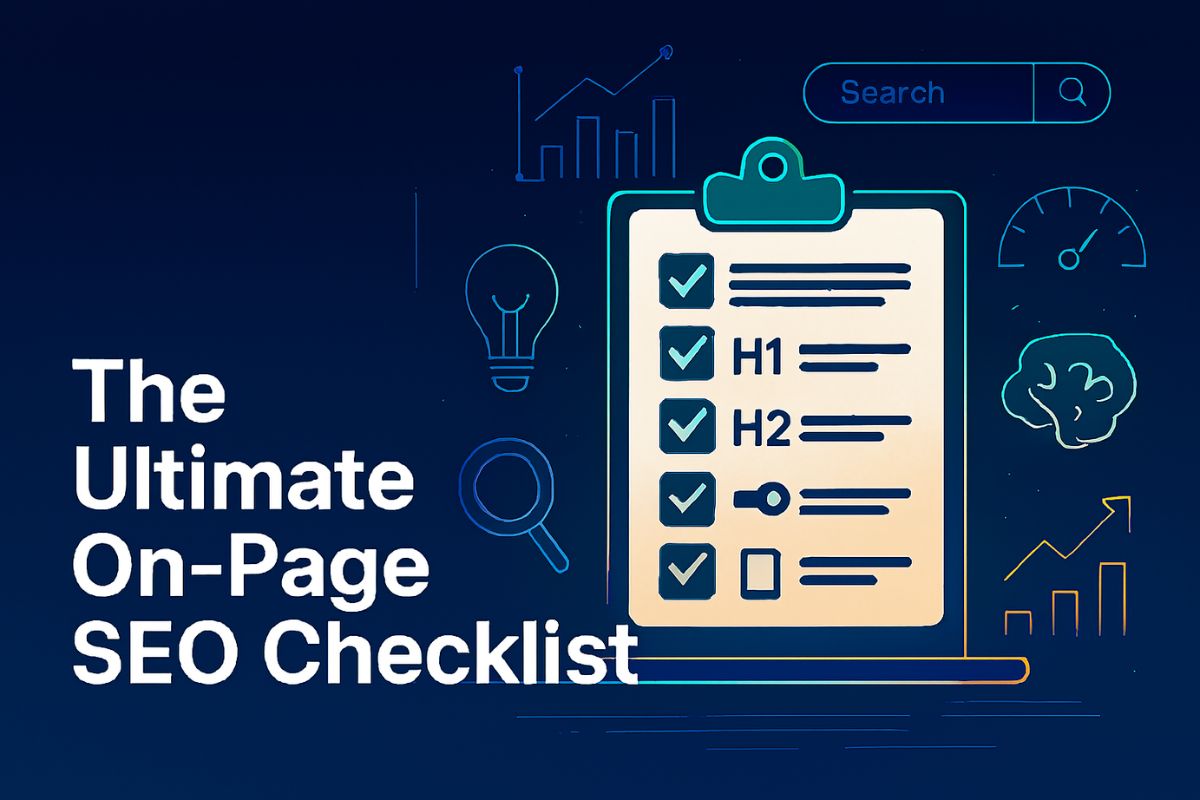A comprehensive on page SEO checklist tailored for 2025 to improve your website’s visibility.
Covers technical and content-based on page SEO checks for better Google rankings.
Includes local context for Indian bloggers, marketers, and small business owners.
Features FAQs based on Google’s “People Also Ask” to answer real user queries.
Ideal for beginners and seasoned SEOs looking to fine-tune their on-page strategy.
If you’ve ever wondered why your beautifully written blog post isn’t ranking on Google, the answer might lie in your on page SEO checklist. In 2025, search engines have become smarter, but they still rely heavily on how well your content is structured, tagged, and optimized. Whether you’re a digital marketer in Lucknow or a blogger in Bangalore, mastering on page SEO is no longer optional—it’s essential.
This guide is your go-to resource for understanding and implementing every critical on page SEO check. From crafting compelling meta descriptions to optimizing image alt tags, we’ll walk you through each step with clarity and purpose. Let’s decode the science behind search visibility and turn your content into a traffic magnet.
What is On Page SEO?
On page SEO (also known as on-site SEO) refers to the practice of optimizing individual web pages to rank higher and earn more relevant traffic in search engines. It involves both the content and the HTML source code of a page.
Why On Page SEO Matters in 2025
With Google’s algorithms becoming more sophisticated, on page SEO checks are more critical than ever. In India, where digital competition is fierce and mobile-first users dominate, optimizing your content for both search engines and users is the key to visibility.
Complete On Page SEO Checklist
1. Keyword Research & Placement
Primary Keyword: on page SEO checklist LSI Keywords: on page SEO checks, SEO on page check list, on-site SEO, technical SEO, content SEO
- Use tools like Google Keyword Planner, Ahrefs, or SEMrush.
- Focus on search intent: informational, transactional, or navigational.
- Place keywords in:
- Title tag
- Meta description
- H1 and H2 tags
- First 100 words
- Image alt text
- URL slug
2. Meta Tags Optimization
| Element | Best Practice Example |
|---|---|
| Title Tag | 50–60 characters, include primary keyword early |
| Meta Description | 150–160 characters, compelling and keyword-rich |
Example: Title: The Ultimate On Page SEO Checklist for 2025 Meta: Master the on page SEO checklist with this expert guide. Learn essential on page SEO checks to improve rankings, user experience, and visibility in 2025.
3. SEO-Friendly URL Structure
- Keep it short, descriptive, and keyword-rich.
- Avoid stop words (and, the, of).
- Use hyphens (-) instead of underscores (_).
Example: www.yoursite.com/on-page-seo-checklist
4. Header Tags (H1–H6)
- Use only one H1 tag per page (usually the title).
- Use H2s for main sections, H3s for sub-sections.
- Include keywords naturally in headers.
5. Content Optimization
- Aim for 2,500–3,000 words for in-depth coverage.
- Use short paragraphs, bullet points, and visuals.
- Maintain a keyword density of 3–4% for on page SEO checklist.
- Use synonyms and LSI keywords to avoid repetition.
6. Image SEO
- Use descriptive file names (e.g.,
on-page-seo-checklist-2025.jpg) - Add alt text with keywords.
- Compress images for faster loading.
7. Internal Linking
- Link to 3–5 relevant internal pages.
- Use descriptive anchor text.
- Helps with crawlability and user navigation.
8. External Linking
- Link to high-authority sources (Moz, Google, Ahrefs).
- Open external links in a new tab.
- Avoid linking to competitors.
9. Mobile Friendliness
- Use responsive design.
- Test with Google’s Mobile-Friendly Test.
- Ensure buttons and fonts are touch-friendly.
10. Page Speed Optimization
- Use tools like Google PageSpeed Insights or GTmetrix.
- Compress images and enable browser caching.
- Minimize CSS, JavaScript, and HTML.
11. Schema Markup
- Add structured data using JSON-LD.
- Use schema types like Article, FAQ, Breadcrumb, and LocalBusiness.
- Helps with rich snippets in SERPs.
12. E-E-A-T Signals (Experience, Expertise, Authoritativeness, Trustworthiness)
- Add author bios with credentials.
- Link to social profiles and contact pages.
- Include testimonials or case studies.
- Use HTTPS and display trust badges.
🇮🇳 Bonus Tips for Indian Bloggers & Businesses
- Use Hinglish or regional keywords if your audience prefers it.
- Optimize for voice search (e.g., “best SEO checklist in Hindi”).
- List your business on Google My Business.
- Add local schema markup for better local SEO.
FAQs
What is an on page SEO checklist?
An on page SEO checklist is a list of tasks to optimize individual web pages for better search engine rankings and user experience.
How do I optimize my meta tags?
Use your primary keyword early in the title tag and write a compelling meta description under 160 characters.
What are the most important on page SEO checks?
Title tags, meta descriptions, header tags, keyword placement, internal linking, and mobile responsiveness.
How many keywords should I use on a page?
Use 1 primary keyword and 3–5 LSI or secondary keywords. Maintain a keyword density of 3–4%.
What is the ideal content length for SEO?
2,000–3,000 words is ideal for in-depth blog posts in 2025.
How do I improve page speed?
Compress images, use caching, and minimize code. Tools like GTmetrix can help.
Should I use schema markup?
Yes! It helps search engines understand your content and can improve click-through rates with rich snippets.
Is internal linking important?
Absolutely. It improves crawlability, distributes link equity, and enhances user experience.
How often should I update my on page SEO?
Review your SEO on page check list every 3–6 months to stay current with algorithm changes.
Can I do on page SEO without coding?
Yes. Most CMS platforms like WordPress offer plugins (e.g., Yoast, Rank Math) to help with on page SEO.
Conclusion: Ready to Rank?
Mastering your on page SEO checklist is like laying the foundation for a skyscraper. Without it, your content might never reach the heights it deserves. Whether you’re a blogger in Delhi or a startup in Lucknow, these strategies will help you climb the SERPs and stay there.
Have questions or tips of your own? Drop a comment below, share this post with your SEO buddies, or reach out—we’d love to hear from you!



